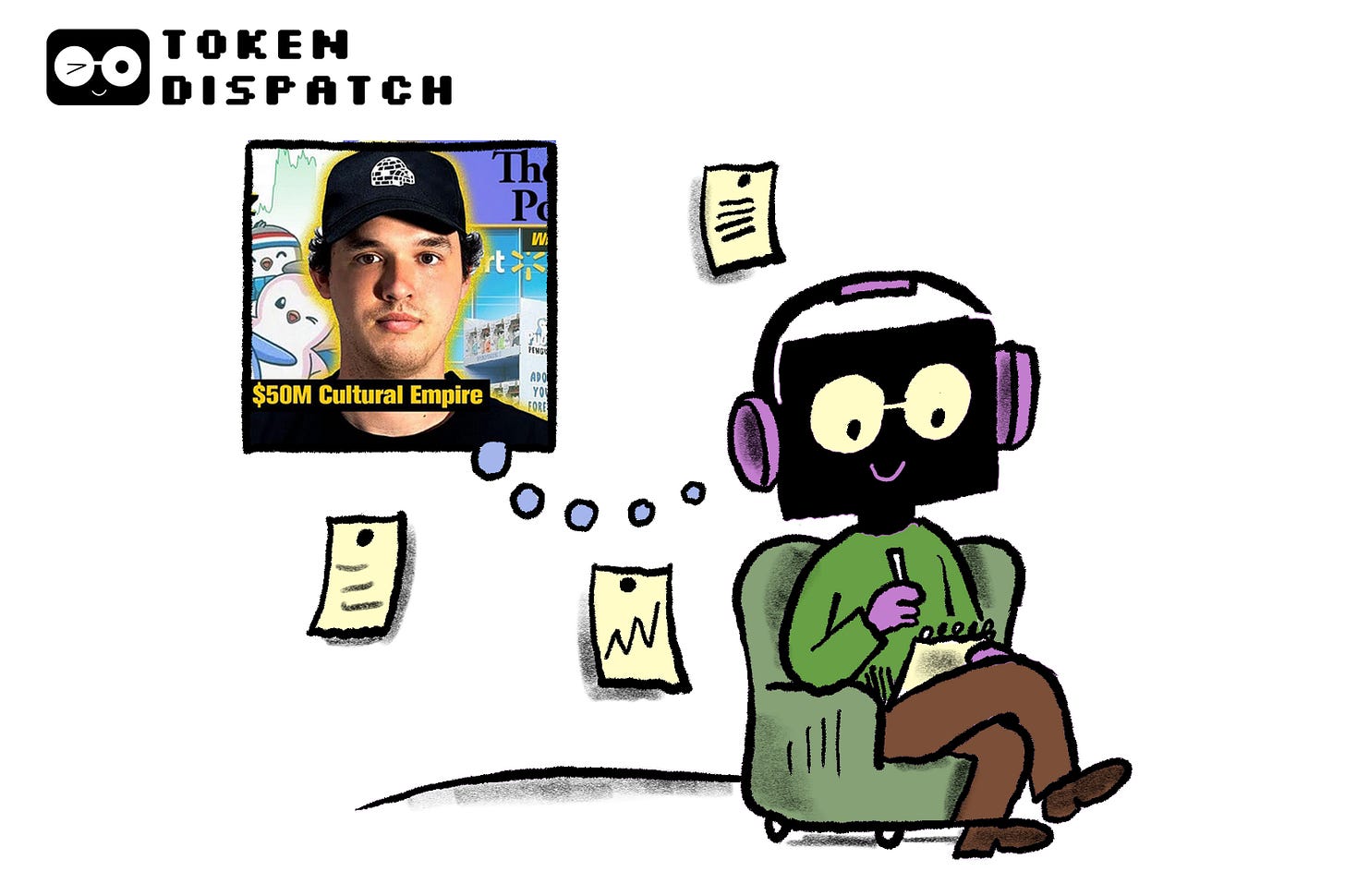Hello
Every week, I listen to a podcast from our partners at Decentralised.co and share my reflections with you.
Today, it’s the conversation hosted by Saurabh Deshapande with Luca Netz, CEO of Pudgy Penguins.
Watch the full episode here 👇🏾
Jimmy Donaldson, known as MrBeast, began making YouTube videos as a teenager in North Carolina. If anyone had told him his content would one day make him a billionaire, he’d likely have laughed. Two decades later, his empire, Beast Enterprises, is valued at over $5 billion. He has built Feastables snacks and MrBeast Burger into massive businesses, all driven by the cultural momentum of his content.
What started with one person making videos has evolved into a nearly $500 million media empire employing 350 people and reaching hundreds of millions globally. If his YouTube channel were a country, it would rank third most populous in the world with 440 million subscribers, which is more than the US population. Reports estimate the average cost of producing each video between $3 million and $4 million.
MrBeast’s content has amassed over 95 billion views, with more than three billion views per month.
This transformation didn’t just happen because Jimmy got better at creating content. It happened because serious money flowed into the creator economy. In 2024, MrBeast’s Feastables, a chocolate business, generated $250 million in sales and a profit of over $20 million, more than what he earned from his videos.
From YouTube’s billion-dollar creator funds to brand partnerships worth millions, to venture capital backing creator businesses, all this capital has done more than fuel creators’ entrepreneurial journeys; it gave their cultural influence staying power and global reach.
This is why Luca Netz’s take on tokenisation felt like déjà vu. Rather than relying on venture capital or platform deals, crypto culture is experimenting with financial systems that allow audiences to invest in the stories, memes, and brands they help spread.
The financialisation of culture shifts how we perceive creativity and intellectual property. For decades, creators faced two paths: find a patron (like a record label, publisher, or platform) who provides capital in exchange for control, or never dream of commercialising the community they build.
Tokenised culture creates a third path: crowdfund cultural movements through financial participation. Instead of convincing a small number of gatekeepers that your intellectual property deserves investment, you can build a community that collectively invests in your cultural vision. If it succeeds, everyone who participated early benefits.
This idea helped me understand Luca’s argument: “Culture can compound and snowball more effectively when it has a layer of financialisation to it. Tokenisation enables us to make intangible things tangible.”
Watch the full episode here 👇🏾
We are already seeing this play out on-chain.
Platforms like Base’s TBA app are financialising creators’ influence and culture directly, by avoiding centralised platforms that take cuts and control the terms of the relationships with their audience. It doesn’t stop there. It allows fans to become stakeholders in the cultural movements they help build.
This core idea stood out to me from Luca Netz’s conversation. I went into that episode expecting the usual tokenomics and memecoin discourse: either dismissive takes about gambling degeneracy or hopeful speculation about community building. Instead, Luca spoke about how we financialise culture itself - something I have seen firsthand in MrBeast’s case.
I liked how Luca summarised the importance of adding a financial layer to culture.
“Culture can compound and snowball more effectively when it has a layer of financialisation to it,” he said, adding that tokenisation helps make “intangible things tangible.”
This is where I find it challenging to attach value. How does anyone accurately value a private company or an artwork in a small marketplace? Accountants might throw a range of valuation approaches that utilise revenue multiples and other metrics. But what I have really been keen to understand is the force that drives this value beyond the numbers. Luca gives an interesting example: Why does Tesla enjoy a significantly higher valuation than BYD, despite the latter making better revenue from car sales? For me, storytelling bridges the gap between implied valuations and tangible numbers. The better the storytelling, the higher the valuation its stakeholders can justify for the company or a business.
We encounter numerous storytellers every day, both physically and virtually on media platforms, who excel at their craft. Yet, most never manage to monetise their craft despite having the intent to do so. It’s this section of people who have benefited the most from the financialisation of culture and its influence.
The ability to raise funds is not the only benefit. The bigger advantage is that they now have a mechanism to capture their economic value directly.
Consider what happens when you add financial rails to a cultural movement. Suddenly, everyone who contributes to that culture, whether through memes, community building, or simply engaging with the content, now has skin in the game. Their contributions now have a value that flows back to them if the movement succeeds.
This changes everything about how cultural movements scale and sustain themselves. Traditional culture relies on passion, which is powerful but finite. Financialised culture, on the other hand, aligns personal incentives with collective success.
Unlock Web3 Insights with Decentralised.co
Long-form stories trusted by the best in Web3. Senior executives from 140+ enterprises trust them to keep them updated on what’s going on in crypto.
Good writing. In-depth conversations. Right in your inbox.
Subscribe to Decentralised.co
I see MrBeast’s business empire and Pudgy Penguins among the most ideal case studies that have benefited the most from the financialisation of culture and influence. Although one is a YouTuber from North Carolina and the other, a pixelated penguin born from the NFT culture, share a common bridge. Both started with memes, relatable stories, or viral content, and then expanded once financial systems were added across multiple businesses.
For MrBeast, it began with venture funding, brand partnerships, and eventually private equity treating him like a media company. For Pudgy Penguins, it was tokenisation, where the community added market value to the culture they were already a part of. Both show that culture and influence may kindle movements, but it’s financial capital that scales these movements and ensures their staying power.
The rationale behind the launch of Pudgy Penguin’s PENGU token explains this perfectly. Pudgy Penguins generates $50 million in annual revenue through traditional business models, including licensing, events, and product sales. But the real interest in Pudgy Penguins was driven by something intangible — culture and relatability.
Billions of GIF views, major corporations adopting penguin PFPs, and toys on the shelves of global retail stores were all in place long before the PENGU token launched.
PENGU, trading around a $1.87 billion valuation, is the market’s attempt to price the cultural impact. The business generates $50 million. Yet the valuation is at over a 20x multiple of the cash flow. What drives cash flow across various business units — from licensing merchandise, to games, to toys and collectables — for a company that was at one point just a struggling NFT collection? It’s the cultural value the community attaches to the Pudgy Penguins ecosystem, driving millions in cash flow and billions in valuation.
This is what I see unfolding across crypto. Projects that successfully build genuine cultural movements have created sustainable value.
However, there’s a catch. Not every memecoin or token represents profound cultural innovation. Most are probably unsustainable speculations on fleeting trends with no lasting impact. Some, however, experiment with new forms of cultural expression and manage to gain mainstream acceptance. Similar to how Dogecoin made waves with its ETF approval last week, and Pudgy Penguins did with its token launch.
What fascinates me is how this will evolve.
We have already seen individual creators use cultural influence to build multi-billion-dollar businesses, like MrBeast did with Feastables or Logan Paul with KSI’s Prime hydration drink brand. These creators raised money through traditional channels, including venture capital, brand deals and distribution. Tokenisation, however, plans to achieve the same thing by leveraging the community.
We’re already seeing glimpses of this on-chain. Platforms like Farcaster’s Frames let creators monetise memes directly, Base’s TBA app allows fans to invest in culture by purchasing creator coins, and Pudgy Penguins turns GIFs and toys into a $1.9 billion market cap token by building multiple business lines around its culture.
This feels like a new way of organising human creativity and collaboration-one that erases the line between audience and investor. And that’s what keeps me so engaged with this space.That’s it for this week’s reflections.
I’ll see you next week,
Prathik
Token Dispatch is a daily crypto newsletter handpicked and crafted with love by human bots. If you want to reach out to 200,000+ subscriber community of the Token Dispatch, you can explore the partnership opportunities with us 🙌
📩 Fill out this form to submit your details and book a meeting with us directly.
Disclaimer: This newsletter contains analysis and opinions of the author. Content is for informational purposes only, not financial advice. Trading crypto involves substantial risk - your capital is at risk. Do your own research.






